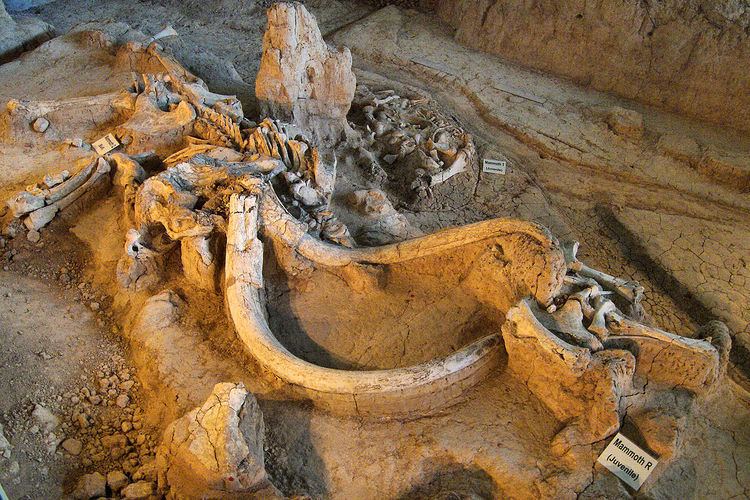Phone +1 254-750-7946 | Area 2 ha Established July 10, 2015 | |
 | ||
Created July 10, 2015 (2015-July-10) Website Waco Mammoth National Monument Address 6220 Steinbeck Bend Dr, Waco, TX 76708, USA Hours Open today · 9AM–5PMThursday9AM–5PMFriday9AM–5PMSaturday9AM–5PMSunday9AM–5PMMonday9AM–5PMTuesday9AM–5PMWednesday9AM–5PMSuggest an edit Similar Mayborn Museum Complex, Cameron Park Zoo, Dr Pepper Museum & Free Ente, Cameron Park, Texas Ranger Hall of Fa | ||
38 000 year old fossils at waco mammoth national monument in texas
The Waco Mammoth National Monument is a paleontological site and museum in Waco, Texas, United States where fossils of twenty-four Columbian mammoths (Mammuthus columbi) and other mammals from the Pleistocene Epoch have been uncovered. The site is the largest known concentration of a single herd of mammoths dying from the same event, which is believed to have been a flash flood. A local partnership developed around the site after the initial bone was discovered. The Waco Mammoth Foundation worked in partnership with the city of Waco and Baylor University to develop the site. In 2015, they successfully sought the National Monument designation to bring the expertise of the National Park Service into the partnership.
Contents
- 38 000 year old fossils at waco mammoth national monument in texas
- Waco mammoth national monument
- HistoryEdit
- DiscoveryEdit
- National MonumentEdit
- References
Waco mammoth national monument
HistoryEdit
Columbian mammoths lived 10,000 to 1 million years ago. They migrated to North America and as far south as Nicaragua. The Columbian mammoth was a herbivore, with a diet consisting of varied plant life ranging from grasses to conifers. At this time, the Central Texas landscape consisted of temperate grasslands and savannahs surrounded by river floodplains.
How the animals at the site died is unknown, but there is no evidence that humans were involved. The current theory is that approximately 68,000 years ago, at least 19 mammoths from a nursery herd were trapped in a steep-sided channel during a flash flood and drowned and/or were buried by mud. A camel was also trapped and killed during this event. Later floods buried the remains. A second event took place sometime later. During this event, an unidentified animal associated with a juvenile saber-toothed cat (genus Smilodon) died and was buried. The third event claimed the lives of a bull mammoth, two juvenile mammoths, and an adult female. Approximately 15,000 years after the nursery herd was trapped, these animals also appear to have been victims of rising water, unable to escape due to the slippery slopes of the surrounding channel.
Luminescence dating of the fossils was done by optically stimulated luminescence (OSL). OSL uses light to excite electrons and cause the emission of photons. The photons can be sensed and measured to calculate when the test sample was last exposed to the sun. The soil near the mammoths' remains was examined using OSL to determine how long the minerals were buried. As the soil was buried at the same time as the mammoths, determining when the soil was last exposed to the sun would correlate to the time when the mammoths perished.
DiscoveryEdit
The site was discovered in 1978 by Paul Barron and Eddie Bufkin, who were searching for arrowheads and fossils near the Bosque River. The men found a large bone and took the bone to the Strecker Museum at Baylor University for analysis. Once identified as a Columbian mammoth, the museum staff organized a formal dig at the site. Between 1978 and 1990, sixteen mammoths were discovered. These first remains were protected with plaster jackets and stored at the Strecker Museum (now the Mayborn Museum Complex). The other remains were excavated between 1990 and 1997. These remains include a large male (bull), a female, two juveniles and a camel (Camelops hesternus) and are in situ at the site.
Though the first bones at the site were discovered in 1978, the site remained closed to the public until the end of 2009. That year, a shelter was completed to protect the bones and allow the site to be viewed by the general public. The site, now run by the City of Waco, Baylor University, and the National Park Service, sits in a 100-plus acre stretch of wooded parkland along the Bosque River.
National MonumentEdit
United States Representative Chet Edwards filed legislation in 2010 to make the site a National Monument and include it as a unit of the National Park Service. The bill passed the House of Representatives but died in the Senate. Representative Bill Flores filed a similar bill in 2012. Again, the bill passed the House of Representatives but died in the Senate.
At 2 p.m. on July 10, 2015, President Barack Obama used his authority under the Antiquities Act to designate the site as Waco Mammoth National Monument, to be managed by the National Park Service in collaboration with the City of Waco and Baylor University. Members of the National Park Service and United States Forest Service and Secretary of the Interior Sally Jewell surrounded President Obama as he signed the executive orders in the Oval Office. The city has deeded the five-acre dig site to the federal government but retains 100 acres around it for future park-related development.
